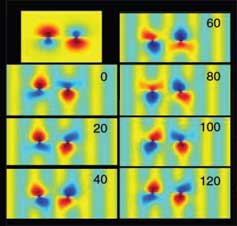
Handy Links
SLAC News Center
SLAC Today
- Subscribe
- Archives: Feb 2006-May 20, 2011
- Archives: May 23, 2011 and later
- Submit Feedback or Story Ideas
- About SLAC Today
SLAC News
Lab News
- Interactions
- Lightsources.org
- ILC NewsLine
- Int'l Science Grid This Week
- Fermilab Today
- Berkeley Lab News
- @brookhaven TODAY
- DOE Pulse
- CERN Courier
- DESY inForm
- US / LHC
SLAC Links
- Emergency
- Safety
- Policy Repository
- Site Entry Form

- Site Maps
- M & O Review
- Computing Status & Calendar
- SLAC Colloquium
- SLACspeak
- SLACspace
- SLAC Logo
- Café Menu
- Flea Market
- Web E-mail
- Marguerite Shuttle
- Discount Commuter Passes
-
Award Reporting Form
- SPIRES
- SciDoc
- Activity Groups
- Library
Stanford
Around the Bay
When Speeding Bullets Seem Slow
 Science at SLAC is changing. It's an evolution driven by new tools and techniques—advances in laser science are enabling researchers to peer deeper than ever before into the world of ultrafast phenomena. In the August 9 edition of the journal
Science, SLAC's director of Photon Ultrafast Laser Science and Engineering (PULSE) Center, Philip Bucksbaum, describes the future of this new, ultrafast or "attosecond" science.
Science at SLAC is changing. It's an evolution driven by new tools and techniques—advances in laser science are enabling researchers to peer deeper than ever before into the world of ultrafast phenomena. In the August 9 edition of the journal
Science, SLAC's director of Photon Ultrafast Laser Science and Engineering (PULSE) Center, Philip Bucksbaum, describes the future of this new, ultrafast or "attosecond" science.
An attosecond may seem like an impossibly brief sliver of time—one attosecond is as short, compared to a full second, as one second is short compared to the age of the entire universe (about 14 billion years, or 400 quadrillion seconds). But within a few tens or hundreds of attoseconds, many processes occur that are fundamental to the world we live in. Metals, for example, are reflective because of the attosecond response of their electrons to light. Electrons also rearrange within atoms in a few attoseconds, motions that ultimately form the basis of all chemistry.
Attosecond processes have been studied indirectly for years in particle decays, using the Heisenberg Uncertainty Principle, which states that very rapid changes must have a correspondingly large spread, or "uncertainty," in their energy. Now, thanks to advancements in tools and techniques, according to Bucksbaum, these ultrafast phenomena may be be studied directly. SLAC's PULSE Center is leading the charge in this rapidly evolving field, with three laser labs at SLAC and two on Stanford's main campus dedicated to pioneering new techniques for understanding ultrafast dynamics. The Linac Coherent Light Source, scheduled to begin operation in 2010, will serve as an ideal platform for advancing the field even further by creating ultrafast pulses of hard x-rays used to probe the dynamics of matter on the atomic scale.
On-site users can download Bucksbaum's paper from the Science Magazine website.
—Brad Plummer, SLAC Today, August 31, 2007
Above image: (Top left) A mathematical depiction of the outermost electron in a carbon dioxide atom. Additional frames show a simulation of what happens to the atom, over the course of 120 attoseconds, when an electron is ejected by a strong laser pulse and then recollides with its parent ion.